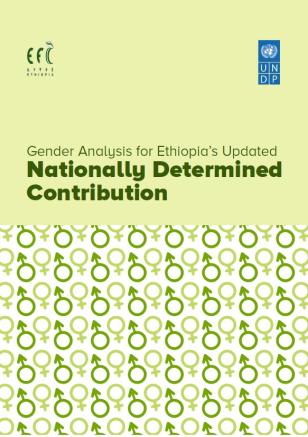Gender Analysis for Ethiopia’s Updated Nationally Determined Contribution

Gender Analysis for Ethiopia’s Updated Nationally Determined Contribution
September 22, 2022
According to the Climate Resilient Green Economy (CRGE) Strategy, the Government of Ethiopia intends to limit its net Green House Gas (GHG) emission in 2030 to 145 Mt CO₂e or lower. This would constitute a 255 Mt CO2e reduction from the projected ‘business-as-usual’ (BAU) emissions in 2030 or a 64% reduction from the BAU scenario in 2030. The implementation of the CRGE would ensure a resilient economic development pathway while decreasing per capita emissions. The CRGE is also integrated into the Second Growth and Transformation Plan (GTP II 2016-2020). In the long term, Ethiopia intends to achieve its vision of becoming carbon-neutral, with the mid-term goal of attaining middle income status. The Climate-Resilient Green Economy (CRGE) initiative follows a sectoral approach and has so far identified and prioritized more than 60 initiatives, which could help the country achieve its development goals while limiting 2030 GHG emissions (FDRE, 2011). In addition according to the National Adaptation Plan (NAP) Ethiopia intends to undertake adaptation initiatives to
reduce the vulnerability of its population, environment, and economy to the adverse effects of climate change, through building adaptive capacity and resilience; and integration of climate change in to its development plan, among others.
Based on the CRGE Ethiopia submitted its first Intended National Determined Contribution (INDC) in 2015 which become Ethiopia’s NDC in 2017. The Nationally Determined Contribution (NDC) of Ethiopia focus on four pillars to mitigate GHG emissions: (1). improving crop and livestock production practices for higher food security and farmer income while reducing emissions, (2) Protecting and re-establishing forests for their economic and ecosystem services, including as carbon stocks, (3) Expanding electricity generation from renewable sources of energy for domestic and regional markets, (4) Leap frogging to modern and energy-efficient technologies in transport, industrial sectors, and buildings (FDRE, 2015). In addition to mitigation efforts Ethiopia’s NDC identified adaptation efforts to reduce vulnerability of livelihoods and landscapes to climate impacts, focusing on three key areas: droughts, floods, and cross-cutting interventions. Many of the initiatives offer positive returns on investments, thus directly promoting economic growth and creating additional jobs with high value
added (CRGE, 2011).
The ten-year Development Plan of Ethiopia, recently released, has mainstreamed climate change targets. Out of 11 sectors that submitted their ten-year development plan 6 has clear climate and environment related plans and targets. However, gender responsiveness of the climate related plans is yet to be seen. Based on the national plan and following the Paris Agreement, the country has submitted its first NDC in 2015 and updated and submitted its second NDC in December 2020. Both the Paris Agreement and the Sustainable Development Goals which Ethiopia is a signatory make gender equality their integral parts. Therefore, gender analysis is required for women inclusion in the implementation of the plan.
The Intergovernmental Panel on Climate Change (IPCC) Fourth Assessment Report (IPCC, 2007) discusses the differential impact of climate change on men and women. The physical, psychological, social, and economic impacts they experience together with the emergency responses, recovery and ultimately reconstruction are different. Women form the majority of the poorest sections of society have the least capacity or opportunity to prepare themselves for the impacts of climate change. The Report also recognizes that women play an important role in disaster reduction, often informally, through participating in disaster management and acting as agents of social change.
Women play an important role in climate change adaptation and mitigation because of their roles in core climate change sectors: agriculture, livestock management, energy, Disaster Risk Reduction (DRR), forestry, water management and health (Dankelman, 2010; Denton, 2002). Because of the different roles and responsibilities of women and men, which vary by socioeconomic level as well as by region, there are gender differences in the impacts of climate change, responses to climate change, vulnerabilities to climate change, and the capacities to adapt. The Gender Analysis for NAP-ETH finds that climate change affects women and men differently due to differences in gender specific vulnerabilities and capacities to cope with the impacts. Due to pervasive gender inequality, compared to men, Ethiopian women normally have lower access to resources, information, participation, and decision-making processes. Climate change further exacerbates these pre-existing inequalities restricting women’s ability to adapt (Alebachew et.al, 2018). However, it must be recognized that both women and men are also potential agents of change for climate change adaptation. Based on their roles and experiences, Ethiopian women and men have experiential knowledge and unique skills and capacities that are valuable for adaptation planning and implementation. Therefore, programme and policy implementation need to take in to account these differences and opportunities to ensure equitable participation and benefit of women in different sectors.

 Locations
Locations